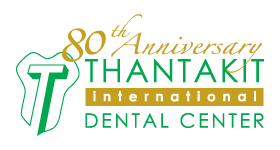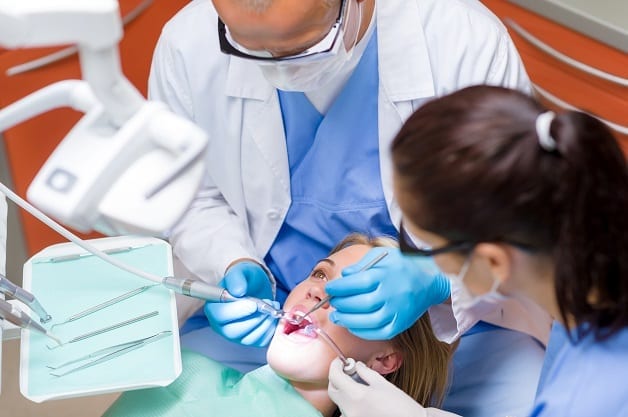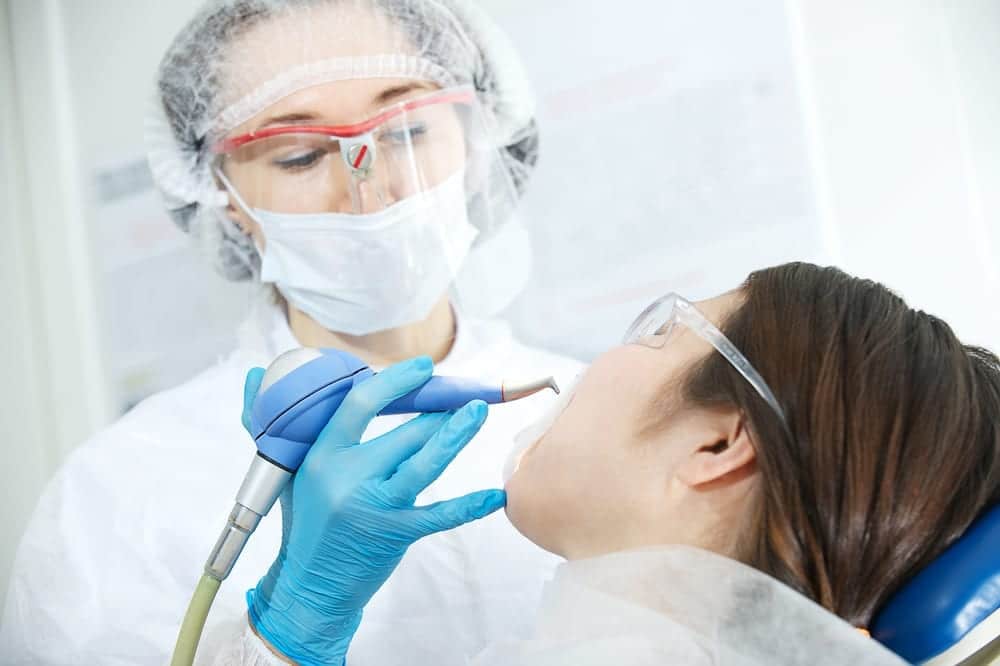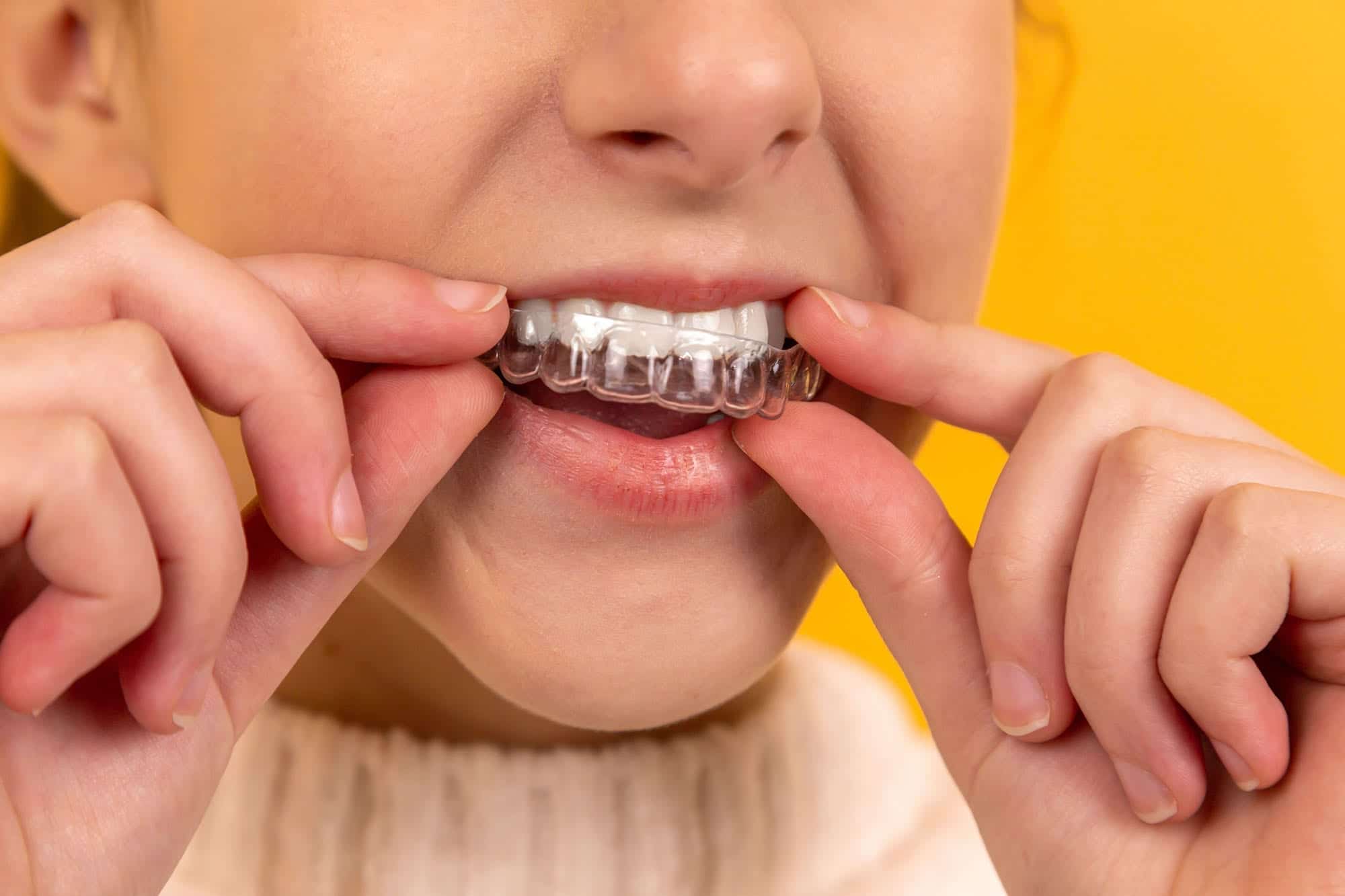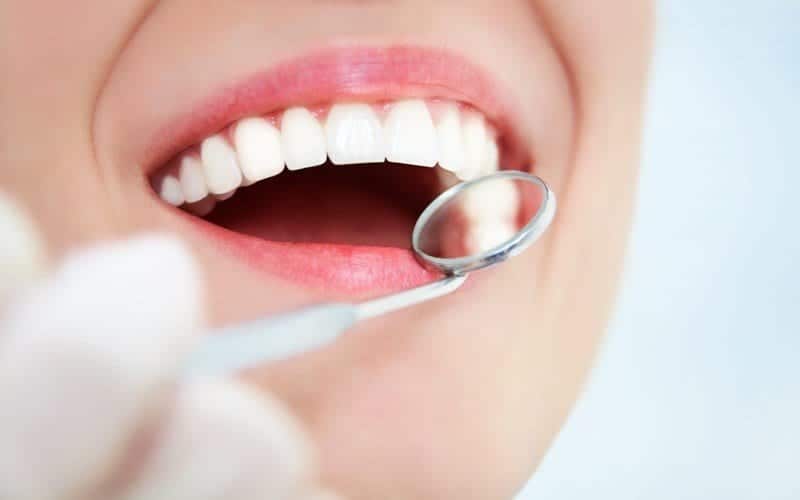Full mouth reconstruction represents one of the most transformative procedures in modern dentistry. As a restorative dentist with over two decades of experience at Thantakit International Dental Center, I’ve guided countless patients through this life-changing journey. Whether you’re considering treatment locally or traveling to Thailand for dental care, understanding the recovery process is essential for achieving optimal results.
This comprehensive guide will walk you through every phase of healing, from the first 48 hours post-surgery through long-term maintenance. At Thantakit, we believe that well-informed patients experience smoother recoveries and better outcomes, which is why we emphasize patient education at every step.
Page Contents
Understanding Full Mouth Reconstruction
Full mouth reconstruction is a comprehensive dental treatment that involves rebuilding or replacing most or all teeth in both the upper and lower jaws. This extensive procedure combines multiple restorative and cosmetic treatments to address severe dental problems affecting function, health, and aesthetics.
When Is Full Mouth Reconstruction Necessary?
In my practice at Thantakit, patients typically require full mouth reconstruction due to:
- Extensive tooth loss from decay, gum disease, or failed previous dental work
- Severe wear and erosion caused by acid reflux, bruxism (teeth grinding), or dietary habits
- Traumatic injuries from accidents, sports, or other physical trauma
- Congenital conditions affecting tooth development or jaw structure
- Complex bite problems (malocclusion) causing pain, TMJ disorders, or difficulty eating
- Failed dental work requiring comprehensive revision
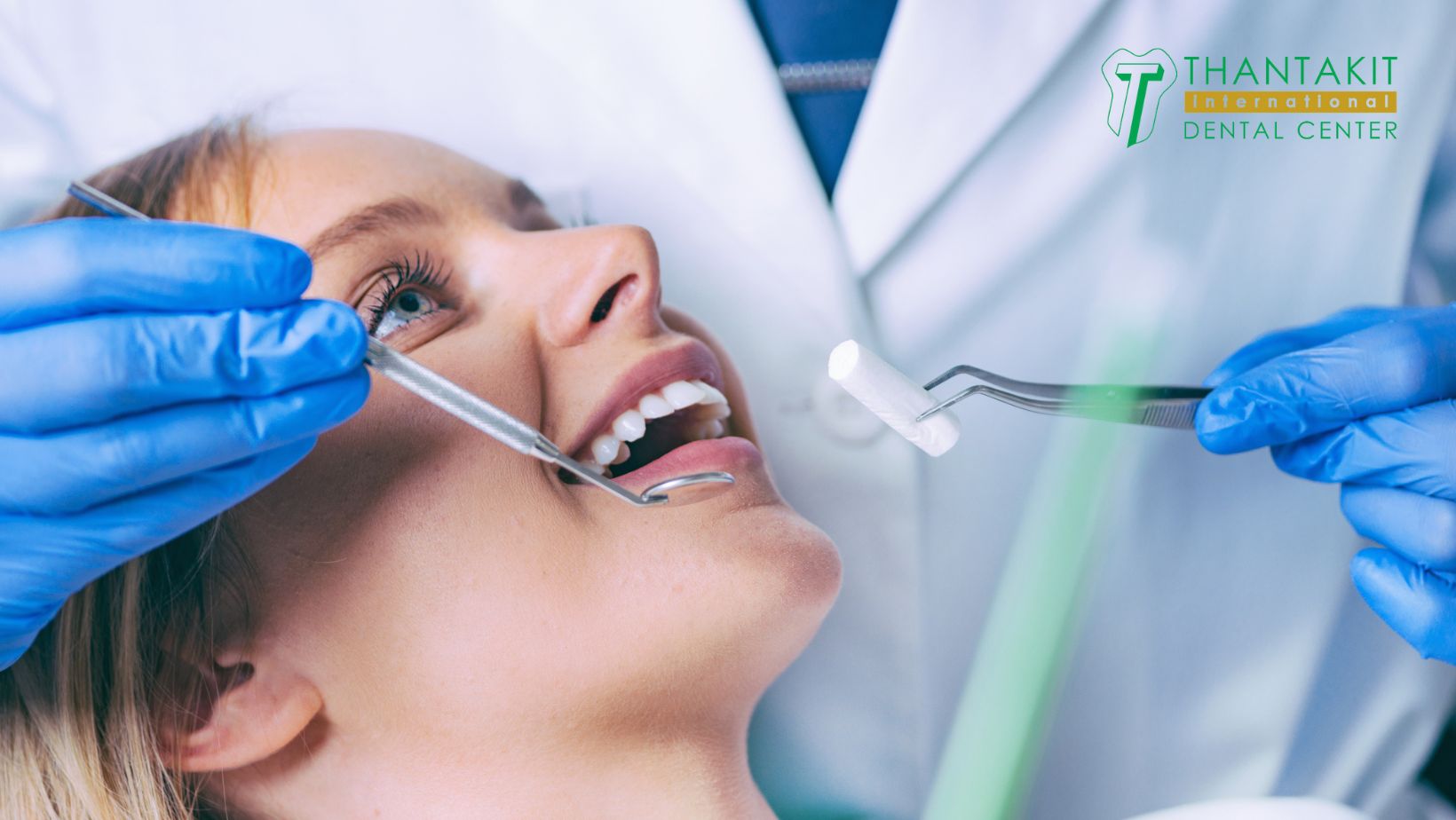
Components of Full Mouth Reconstruction
Every patient’s treatment plan is unique, but at Thantakit, we commonly incorporate these procedures:
- Dental implants: Titanium posts surgically placed in the jawbone to replace missing tooth roots
- Dental crowns: Custom-made caps that restore damaged teeth or cover implants
- Bridges: Fixed prosthetics that span gaps created by missing teeth
- Veneers: Thin porcelain shells that improve the appearance of front teeth
- Bone grafting: Procedures to rebuild jawbone density for implant support
- Gum treatments: Addressing periodontal disease or reshaping gum tissue
- Orthodontic treatment: Aligning teeth before final restorations
The complexity of full mouth reconstruction requires careful planning. At Thantakit, we use advanced 3D imaging and digital smile design technology to create precise treatment plans that preview your final results before we begin.
The Treatment Timeline: What to Expect
Understanding the typical timeline helps patients prepare mentally and logistically for their transformation. While every case differs, here’s what most patients experience at our Bangkok facility:
Initial Phase (1-2 weeks)
- Comprehensive examination and diagnostic imaging
- Treatment planning and case presentation
- Addressing urgent issues (infections, extractions)
- Temporary restorations if needed
Active Treatment Phase (3-6 months)
- Surgical procedures (implant placement, bone grafting)
- Healing periods between procedures
- Fabrication of custom restorations
- Progressive adjustments and refinements
Final Phase (1-2 months)
- Placement of permanent restorations
- Bite adjustments and fine-tuning
- Final aesthetic enhancements
- Patient education for long-term care

What to Expect: Immediate Recovery (First 48 Hours)
The first two days after surgery are crucial for setting the foundation for successful healing. Based on my experience treating thousands of patients at Thantakit, here’s what you can expect:
Normal Post-Surgical Symptoms
- Swelling: Peaks at 48-72 hours, particularly after implant placement or bone grafting
- Discomfort: Manageable with prescribed medications
- Minor bleeding: Light oozing from surgical sites for 24-48 hours
- Difficulty speaking: Temporary, especially with new temporary teeth
- Fatigue: Your body needs energy for healing
Essential Care Instructions
At Thantakit, we provide detailed post-operative instructions, but here are the key points:
- Medication Management
- Take prescribed antibiotics exactly as directed
- Use pain medication before discomfort becomes severe
- Continue any regular medications unless advised otherwise
- Swelling Control
- Apply ice packs: 20 minutes on, 20 minutes off
- Keep your head elevated, even while sleeping
- Avoid bending over or strenuous activities
- Oral Hygiene
- Do not rinse or spit forcefully for 24 hours
- After 24 hours, rinse gently with prescribed antimicrobial solution
- Avoid brushing surgical sites but clean other teeth carefully
- Diet Guidelines
- Clear liquids only for the first 24 hours
- No hot beverages or foods
- Avoid using straws (suction can dislodge blood clots)
- Stay well-hydrated with room temperature water

Weeks 1-2: Soft Foods and Early Healing
The first two weeks mark a critical transition period. At Thantakit, we schedule follow-up appointments during this time to monitor healing and address any concerns.
Physical Changes You’ll Experience
During this phase, patients typically notice:
- Gradual reduction in swelling
- Decreased discomfort as tissues heal
- Improved ability to speak clearly
- Increasing comfort with temporary restorations
Dietary Progression
Nutrition plays a vital role in healing. Here’s how we recommend progressing your diet:
Week 1 Options:
- Protein shakes and smoothies (no seeds or chunks)
- Creamy soups at room temperature
- Yogurt and pudding
- Mashed potatoes or sweet potatoes
- Scrambled eggs
- Well-cooked oatmeal
Week 2 Additions:
- Soft fish (salmon, tilapia)
- Pasta with smooth sauces
- Soft-cooked vegetables
- Cottage cheese
- Hummus
- Banana and other soft fruits
Oral Hygiene Routine
Maintaining cleanliness without disrupting healing requires a modified approach:
- Gentle Rinsing: Use prescribed antimicrobial rinse 2-3 times daily
- Modified Brushing: Use an extra-soft toothbrush on non-surgical areas
- Avoid Surgical Sites: Clean around them, not on them
- No Commercial Mouthwash: Alcohol content can irritate healing tissues
Warning Signs to Report
Contact our Thantakit team immediately if you experience:
- Fever above 38°C (100.4°F)
- Increasing pain after day 3
- Excessive bleeding or discharge
- Loosening of temporary restorations
- Difficulty swallowing
Weeks 3-6: Adjusting to Temporary Teeth
This phase brings significant improvements in comfort and function. Many patients at Thantakit report feeling more like themselves during this period.
What’s Happening in Your Mouth
- Soft tissue healing completes
- Initial bone healing around implants begins
- Gums adapt to temporary restorations
- Bite patterns start to normalize
Expanding Your Diet
By week 3, most patients can enjoy:
- Tender cooked meats (chicken, ground beef)
- Steamed vegetables
- Soft breads without hard crusts
- Rice and quinoa
- Soft cheeses
- Most fruits (avoid very hard or sticky ones)
Fine-Tuning Temporary Restorations
At Thantakit, we often schedule adjustment appointments during this period to:
- Refine the bite for comfort
- Address any sore spots
- Ensure proper cleaning access
- Make aesthetic improvements
Psychological Adjustment
This period often brings emotional ups and downs. It’s normal to experience:
- Excitement about visible improvements
- Impatience for final results
- Occasional frustration with limitations
- Anxiety about the healing process
Our team provides ongoing support to help patients navigate these feelings. Remember, this is temporary, and the final results will be worth the journey.
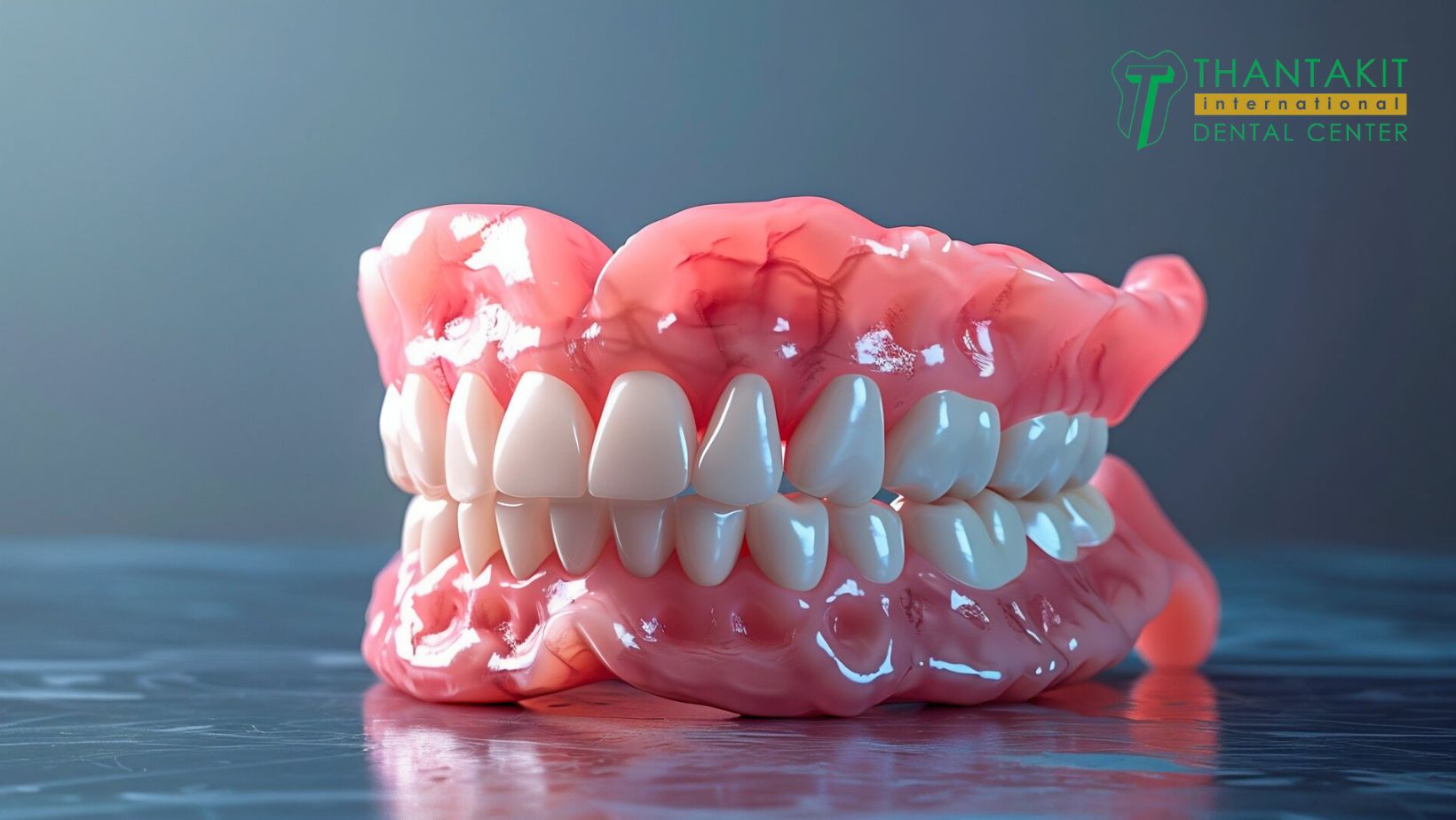
Months 2-6: Osseointegration and Progress Checks
This phase is perhaps the most critical for long-term success, particularly for patients with dental implants. Osseointegration—the process by which implants fuse with your jawbone—occurs primarily during this period.
Understanding Osseointegration
Osseointegration is a remarkable biological process discovered by Professor Per-Ingvar Brånemark. Here’s what happens:
- Weeks 1-4: Initial bone healing and blood clot organization
- Weeks 4-8: New bone cells begin forming around the implant
- Weeks 8-12: Bone density increases, creating initial stability
- Months 3-6: Complete integration with mature, strong bone
At Thantakit, we use high-quality titanium implants that promote optimal osseointegration. Success rates exceed 95% when patients follow our protocols.
Monitoring Your Progress
Regular check-ups during this phase allow us to:
- Assess integration through X-rays
- Test implant stability
- Evaluate soft tissue health
- Plan for final restorations
- Address any concerns promptly
Lifestyle Considerations
During osseointegration, certain factors can impact success:
Positive Factors:
- Good nutrition with adequate calcium and vitamin D
- Regular gentle exercise
- Excellent oral hygiene
- Avoiding tobacco products
- Managing stress effectively
Risk Factors to Avoid:
- Smoking or tobacco use (significantly impairs healing)
- Excessive alcohol consumption
- Poor blood sugar control (for diabetic patients)
- Certain medications (discuss with your dentist)
Diet During Osseointegration
While you’ll have more dietary freedom, we still recommend:
- Avoiding extremely hard foods (nuts, hard candies)
- Cutting food into smaller pieces
- Chewing evenly on both sides
- Staying hydrated for saliva production
- Including protein-rich foods for healing
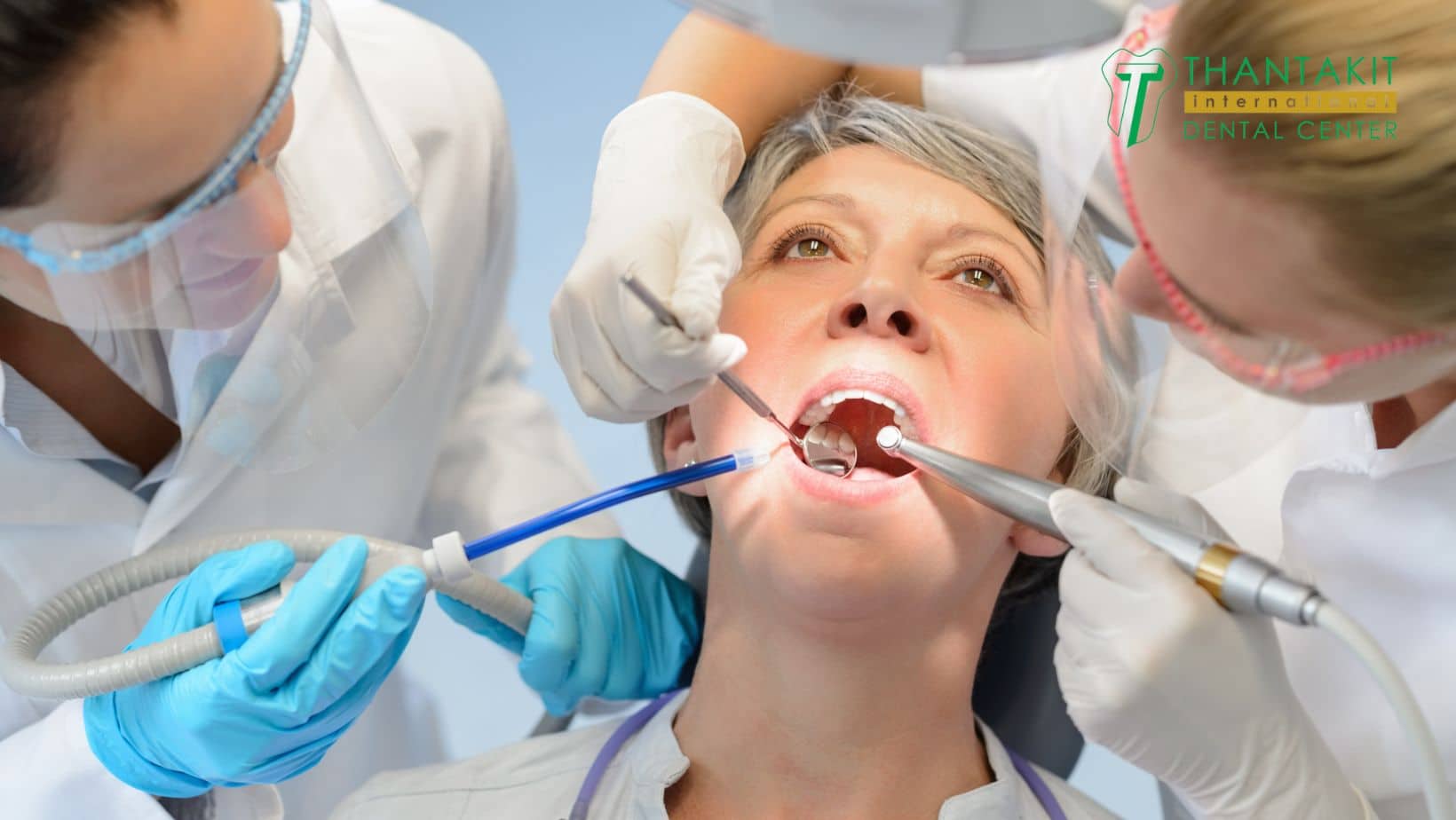
Months 6-12: Permanent Teeth and Final Adjustments
The culmination of your journey arrives when we place your permanent restorations. This exciting phase at Thantakit involves precision, artistry, and attention to detail.
The Process of Placing Permanent Restorations
- Final Impressions: Using digital scanners for maximum accuracy
- Shade Selection: Matching your new teeth to your preferences
- Laboratory Fabrication: Our master technicians create your custom restorations
- Try-In Appointment: Evaluating fit, function, and aesthetics
- Final Cementation: Permanently securing your new teeth
- Bite Adjustment: Fine-tuning for optimal comfort
What to Expect with Your New Teeth
Patients often report these experiences:
- Initial awareness of the new teeth (settles within days)
- Dramatic improvement in chewing efficiency
- Enhanced speech clarity
- Increased confidence in social situations
- Need for minor adjustments as you adapt
Final Aesthetic Touches
At Thantakit, we often perform these finishing procedures:
- Professional teeth whitening for natural teeth
- Gum contouring for ideal symmetry
- Minor orthodontic adjustments if needed
- Final photography to document your transformation
Long-Term Care and Hygiene Essentials
Your investment in full mouth reconstruction at Thantakit deserves protection through proper long-term care. Here’s my comprehensive guide for maintaining your results for decades to come.
Daily Home Care Routine
Morning Routine:
- Brush for 2 minutes with soft-bristled electric toothbrush
- Use fluoride toothpaste recommended by your dentist
- Clean between teeth with water flosser or interdental brushes
- Rinse with antimicrobial mouthwash if prescribed
Evening Routine:
- Repeat morning brushing technique
- Pay special attention to gum line areas
- Use specialized cleaning tools for bridges or implants
- Consider using a night guard if you grind your teeth
Professional Maintenance Schedule
At Thantakit, we recommend:
- Every 3-4 months: Professional cleaning and examination (first year)
- Every 6 months: Routine maintenance visits (after first year)
- Annually: Comprehensive examination with X-rays
- Every 3-5 years: Detailed implant assessment
Protecting Your Investment
To ensure longevity of your reconstruction:
- Avoid Damaging Habits
- Don’t use teeth as tools
- Avoid chewing ice or hard objects
- Wear sports guards during activities
- Address teeth grinding promptly
- Maintain Overall Health
- Control systemic conditions (diabetes, heart disease)
- Stay hydrated for optimal saliva production
- Eat a balanced, nutritious diet
- Avoid tobacco in all forms
- Monitor for Changes
- Report any looseness immediately
- Watch for gum inflammation or bleeding
- Note changes in bite or comfort
- Address issues before they escalate
Special Considerations for Implant Care
Dental implants require specific attention:
- Use low-abrasive toothpaste
- Choose plastic-coated interdental brushes
- Avoid metal instruments near implants
- Have professional cleanings with specialized tools
Common Challenges During Recovery
Throughout my years at Thantakit, I’ve helped patients navigate various recovery challenges. Understanding these helps you prepare and respond appropriately.
Physical Challenges
Speech Difficulties
- Temporary lisping with new teeth
- Usually resolves within 2-3 weeks
- Practice reading aloud helps adaptation
Eating Adjustments
- Learning new chewing patterns
- Initial tendency to bite cheeks or tongue
- Improves with conscious practice
Sensitivity Issues
- Temperature sensitivity in natural teeth
- Usually temporary as teeth adjust
- Desensitizing toothpaste helps
Emotional and Psychological Aspects
Adjustment Period Many patients experience:
- Feeling that teeth are “too big” initially
- Self-consciousness about appearance changes
- Anxiety about damaging new teeth
- Impatience during healing phases
At Thantakit, we provide counseling and support throughout this transition. Remember, these feelings are normal and temporary.
Managing Expectations
- Final results take time to achieve
- Minor adjustments are often needed
- Adaptation period varies by individual
- Patience leads to better outcomes
Complications and Solutions
While rare at Thantakit, potential complications include:
Implant-Related Issues
- Failure to integrate (under 5% of cases)
- Peri-implantitis (preventable with good hygiene)
- Solution: Early intervention and possible replacement
Prosthetic Challenges
- Porcelain chipping or fracture
- Cement wash-out
- Solution: Prompt repair or replacement
Soft Tissue Problems
- Persistent inflammation
- Gum recession
- Solution: Professional treatment and improved home care
FAQs for Full Mouth Restoration Patients
Based on thousands of patient interactions at Thantakit, here are comprehensive answers to common questions:
How long until I can eat normally?
Most patients resume a relatively normal diet by 3-4 months, though full freedom comes after final restorations are placed (6-12 months). The progression depends on your specific procedures and healing rate.
Will my new teeth feel natural?
Yes, after an adaptation period of 2-4 weeks, most patients report their restorations feel completely natural. The brain remarkably adapts to recognize them as your own teeth.
How long do full mouth reconstructions last?
With proper care at Thantakit:
- Dental implants: 25+ years (often lifetime)
- Crowns and bridges: 10-15 years average
- Veneers: 10-20 years Regular maintenance significantly extends longevity.
Can I whiten my new teeth?
Porcelain restorations don’t respond to whitening. We match them to your desired shade during fabrication. Natural remaining teeth can be whitened before final restoration placement.
What if I travel home before treatment completes?
Thantakit coordinates with your home dentist for continuity of care. We provide:
- Detailed treatment records
- Digital imaging files
- Direct communication with your dentist
- Remote consultation support
Is age a limiting factor?
Age alone doesn’t disqualify patients. At Thantakit, we’ve successfully treated patients from their 20s to their 80s. Overall health matters more than chronological age.
How do I handle emergencies during recovery?
We provide:
- 24/7 emergency contact numbers
- Detailed emergency protocols
- Coordination with local providers if traveling
- Video consultation options
Planning Dental Travel to Thailand: What You Should Know
As one of Thailand’s premier dental destinations, Thantakit International Dental Center has perfected the dental tourism experience. Here’s comprehensive guidance for international patients:
Pre-Arrival Planning
Initial Consultation
- Virtual consultations via video call
- Digital X-ray and photo evaluation
- Preliminary treatment planning
- Cost estimation and timeline
Travel Arrangements
- Plan minimum 2-3 weeks for initial phase
- Book accommodations near our Bangkok clinic
- Arrange for companion if having surgery
- Consider travel insurance with medical coverage
Medical Preparation
- Complete health history forms
- Obtain medical clearance if needed
- Arrange prescription transfers
- Stop blood thinners as directed
During Your Stay in Bangkok
Treatment Logistics
- Airport pickup can be arranged
- English-speaking staff throughout
- Flexible scheduling for tourists
- Assistance with local arrangements
Recovery Accommodations
- Partnerships with nearby hotels
- Quiet rooms for rest
- Easy access to soft foods
- Close proximity to clinic
Making the Most of Downtime Between appointments, enjoy:
- Gentle sightseeing (avoid strenuous activities)
- Thai massage (avoid face/jaw area)
- Shopping in air-conditioned malls
- Sampling soft Thai cuisine
Follow-Up Care Coordination
Before Departure
- Comprehensive care instructions
- Emergency medication supply
- Digital records transfer
- Follow-up schedule planning
Remote Support
- Video consultations as needed
- Coordination with home dentist
- Shipping of supplies if required
- Long-term treatment planning
Cost Considerations for Dental Tourists
Thantakit offers:
- Transparent, itemized pricing
- Significant savings versus Western countries
- Package deals for comprehensive treatment
- Various payment options
Remember to factor in:
- Travel and accommodation costs
- Time away from work
- Potential return visits
- Long-term maintenance at home
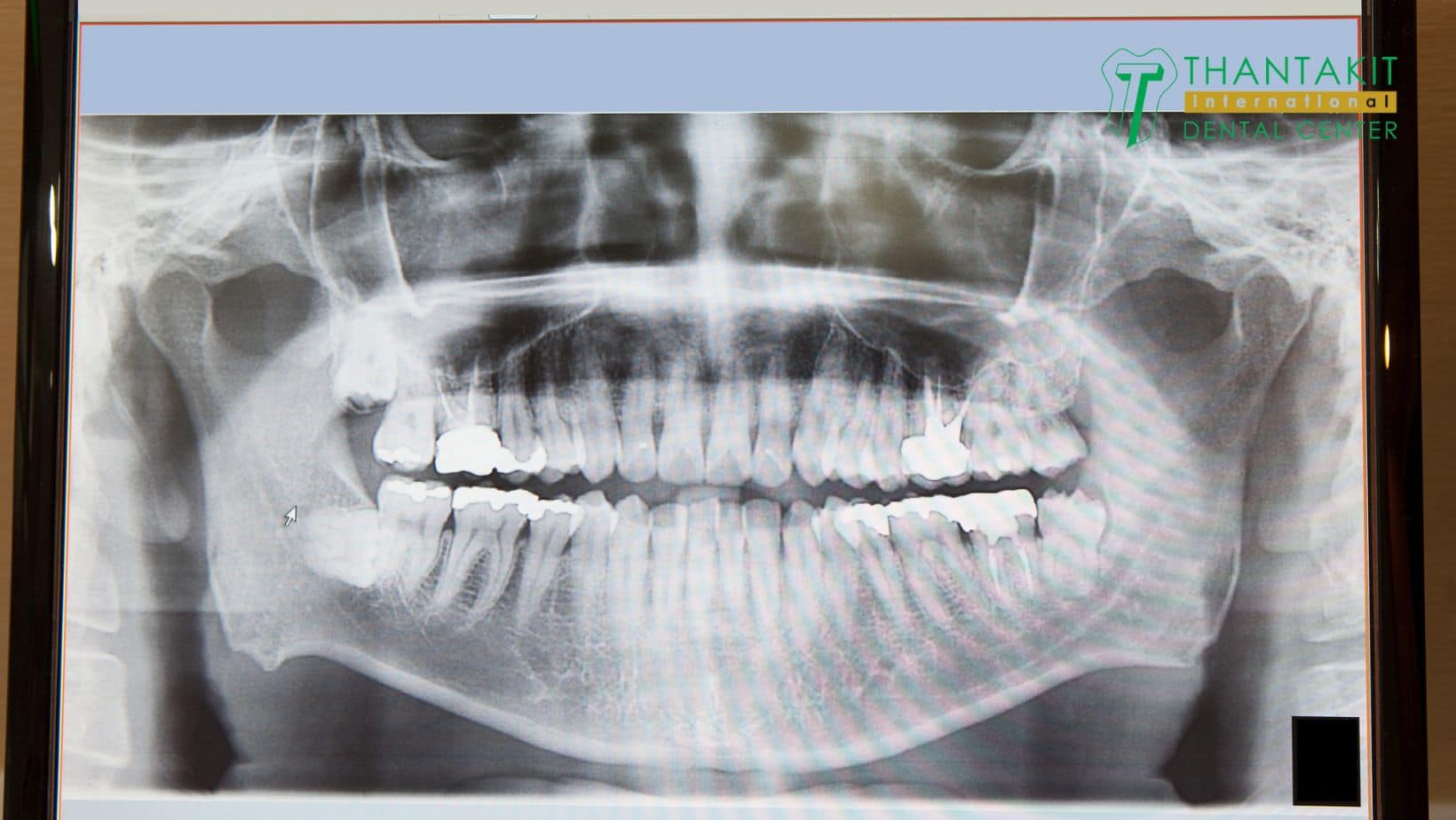
Your Partner in Transformation
Full mouth reconstruction represents more than dental treatment—it’s a journey toward renewed health, function, and confidence. At Thantakit International Dental Center, we’ve guided thousands of patients through this transformative process with exceptional results.
Our combination of advanced technology, skilled specialists, and compassionate care creates an environment where healing thrives. Whether you’re a local Bangkok resident or traveling from abroad, we’re committed to making your reconstruction journey as smooth and successful as possible.
The road to your new smile requires patience, commitment, and proper care, but the destination—a healthy, beautiful, functional smile—makes every step worthwhile. With careful planning, attentive recovery care, and long-term maintenance, your full mouth reconstruction can provide decades of improved quality of life.
If you’re considering full mouth reconstruction, I encourage you to schedule a consultation with our team at Thantakit. Together, we’ll create a personalized treatment plan that addresses your unique needs and goals, guiding you toward the smile you deserve.
Ready to begin your smile transformation?
Our internationally respected team at Thantakit is here to support you—whether you’re planning a visit to Thailand or exploring your treatment options. Contact us today to speak with one of our friendly, multilingual coordinators. A confident, functional smile could be just one step away.
